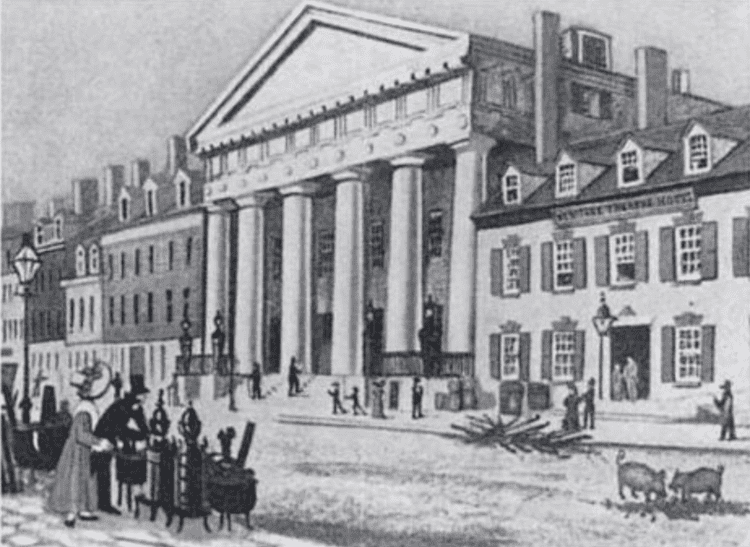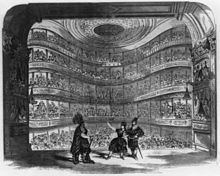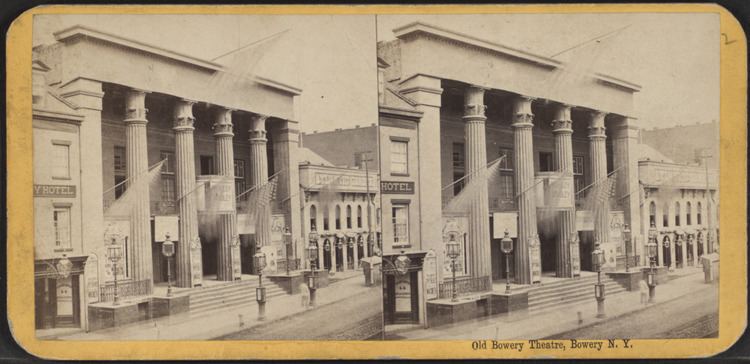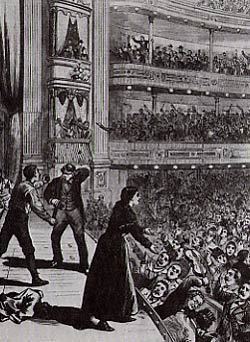Opened 4 August 1845 | Demolished 5 June 1929 | |
 | ||
Address 46 BoweryNew YorkNY 10013 Similar Niblo's Garden, Park Theatre, Barnum's American Museum, Atlantic Garden, Winter Garden Theatre | ||
The Bowery Theatre was a playhouse on the Bowery in the Lower East Side of Manhattan, New York City. Although it was founded by rich families to compete with the upscale Park Theatre, the Bowery saw its most successful period under the populist, pro-American management of Thomas Hamblin in the 1830s and 1840s. By the 1850s, the theatre came to cater to immigrant groups such as the Irish, Germans, and Chinese. It burned down four times in 17 years, a fire in 1929 destroying it for good. Although the theatre's name changed several times (Thalia Theatre, Fay's Bowery Theatre, etc.), it was generally referred to as the "Bowery Theatre".
Contents

Founding and early management
By the mid-1820s, wealthy settler families in the new ward that was made fashionable by the opening of Lafayette Street, parallel to the Bowery, wanted easy access to fashionable high-class European drama, then only available at the Park Theatre. Under the leadership of Henry Astor, they formed the New York Association and bought the land where Astor's Bull's Head Tavern stood, facing the neighborhood and occupying the area between Elizabeth, Canal (then called Walker), and Bayard streets. They hired architect Ithiel Town to design the new venue.

Some notable investors included Samuel Laurence Gouverneur, son-in-law to President James Monroe, and James Alexander Hamilton, son of Alexander Hamilton.

The new playhouse, with its Neoclassical design, was more opulent than the Park, and it seated 3,500 people, making it the biggest theatre in the United States at the time. Frances Trollope compared it to the Park Theatre as "superior in beauty; it is indeed as pretty a theatre as I ever entered, perfect as to size and proportion, elegantly decorated, and the scenery and machinery equal to any in London...."

The Bowery Theatre opened on 22 October 1826 under the name New York Theatre, with the comedy The Road to Ruin, by Thomas Holcroft, under the management of Charles A. Gilfert. New York Mayor Philip Hone spoke at the opening ceremony, imploring the theatre's intended upper-class audience: "It is therefore incumbent upon those whose standing in society enables them to control the opinions and direct the judgment of others, to encourage, by their countenance and support, a well-regulated theatre." Its first few seasons were devoted to ballet, opera, and high drama. The theatre was by this time quite fashionable, and the northward expansion of Manhattan gave the theatre access to a large patronage. The theatre burnt out in 1828, but was rebuilt behind the same facade and reopened under the name Bowery Theatre. Gilfert's understanding of advertising was keen, but in 1829 the owners fired him.
Hamblin's tenure
The owners hired Thomas Hamblin and James H. Hackett in August 1830 to manage the theatre. A month later, Hackett left Hamblin in complete control. After the Bowery burned down later that year, Hamblin rebuilt. He then took the theatre in a decidedly different direction for what would be its most innovative and successful period.
American theatres stratified in the Jacksonian Era, and the Bowery emerged as the home of American nativists and populist causes, placing it in direct contrast to the Park Theatre's cultivated image of traditional European high culture. This was partially the result of an anti-British theatre riot at the Park; Hamblin renamed the playhouse "the American Theatre, Bowery" in reaction. Hamblin hired unknown American actors and playwrights and allowed them to play for long runs of up to a month. Before 1843, early blackface performers such as George Washington Dixon and Thomas D. Rice played there frequently, and acts such as J. B. Booth, Edwin Forrest, Louisa Lane Drew, and Frank Chanfrau also gained renown on the Bowery's stage. George L. Fox and his pantomime became the most popular act at the Bowery until after the Civil War. Bowery productions also debuted or popularized a number of new character types, including the Bowery B'hoy, the Yankee, the Frontiersman, and the blackface Negro.
The pro-Americanism of the Bowery's audience came to a head during the Farren Riots of 1834. Farren, the Bowery's British-born stage manager, had reportedly made anti-American comments and fired an American actor. Protesters reacted by attacking the homes, businesses, and churches of abolitionists and blacks in New York City and then storming the theatre on 9 July. Farren apologized for his comments, and George Washington Dixon sang popular songs to quell the rioters.
Hamblin defied conventions of theatre as high culture by booking productions that appealed to working-class patrons and by advertising them extensively according to Gilfert's model. Animal acts, blackface minstrel shows, and melodrama enjoyed the most frequent billings, and hybrid forms, such as melodramas about dogs saving their human masters, became unprecedented successes. Spectacular productions with advanced visual effects, including water and fire, featured prominently. Hamblin also innovated by using gas lighting in lieu of candles and kerosene lamps. The Bowery Theatre earned the nickname "The Slaughterhouse" for its low-class offerings, and terms like "Bowery melodrama" and "Bowery actors" were coined to characterize the new type of theatre.
In the spring of 1834, Hamblin began buying shares in the theatre from the New York Association; he had enough to control the enterprise completely within 18 months. By the time the Bowery burned again in September 1836, it was the most popular playhouse in New York City, despite steep increases in competition (the Bowery Amphitheatre was right across the street). Visual spectacle had become such an integral part of its appeal that Hamblin claimed $5,000 in wardrobe losses from the fire. Hamblin bought out the remaining shares in the theatre and rented the site to W. E. Dinneford and Thomas Flynn, who rebuilt. When this interim Bowery burned down in February 1838, Hamblin replaced it with a bigger and more opulent structure, which opened in May 1839.
Through Hamblin's actions, working-class theatre emerged as a form in its own right, and melodrama became the most popular form of American theatre. Low-class patrons such as Bowery b'hoys and g'hals predominated in the audience. The Spirit of the Times described the Bowery's patrons:
Some sources even suggest that patrons engaged in sexual behavior in the lobbies and boxes. Understandably, Hamblin was careful to remain in this crowd's good graces. For example, he regularly offered use of the Bowery Theatre for the annual firemen's ball. Only the Chatham Garden Theatre boasted a rowdier audience.
Profits were harder to come by in the 1840s, as more playhouses sprung up in New York. Hamblin staged more effects-driven melodrama and later increased bookings of circus acts, minstrel shows, and other variety entertainments. The Bowery burned down once more in April 1845. This time, Hamblin had fire insurance, and he rebuilt with an eye toward appealing to a more upscale patronage and to staging more spectacular melodrama. The theatre now seated 4,000 and with a stage 126 feet (38 m) square, secured its place as one of the largest playhouses in the world. The architect and builder of the new theatre was J. M. Trimble. Hamblin left the management to A. W. Jackson, though Jackson and later managers largely upheld Hamblin's emphasis on melodrama and visual splendor. Hamblin died in January 1853, and the theatre remained in his family until 1867.
Successful plays of Hamblin's tenure included:
Later management
By the middle of the 19th century, immigrant groups, notably the Irish, began populating the Bowery neighborhood. They came to form a significant portion of the Bowery's audience, mostly in the low-price gallery section. In order to cater to them, the theatre offered plays by James Pilgrim and other Irish playwrights. Meanwhile, the Bowery emerged as the theatrical center for New York's Lower East Side.
Germans Gustav Amberg, Heinrich Conried, and Mathilde Cottrelly converted the Bowery into the Thalia Theatre in 1879, offering primarily German theatre during their ownership. In 1891, Yiddish theatre became the predominant attraction. Italian vaudeville succeeded this, followed by Chinese vaudeville.
In 1894, Maria Roda addressed a large rally at the Thalia Theater celebrating Emma Goldman's release from prison. Although Roda spoke in Italian and Goldman understood none of it, she was moved by Roda's charismatic presence. She wrote, "Maria's strange beauty and the music of her speech roused the whole assembly to tensest enthusiasm. Maria proved a veritable ray of sunlight to me." She then pledged to become Maria Roda's "teacher, friend, comrade."
"Fay's Bowery Theatre" burned down on 5 June 1929 under Chinese management and was never rebuilt.
